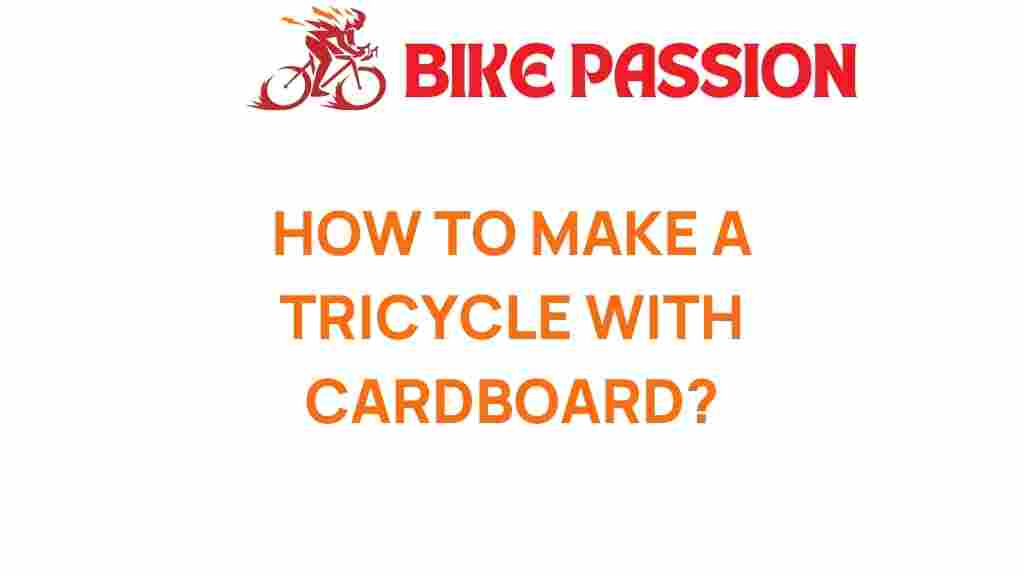Unleashing Creativity: How to Make a Tricycle with Cardboard
In a world filled with digital distractions, finding ways to engage children in creative play is essential. One of the most enjoyable and sustainable activities is crafting with cardboard. In this article, we’ll guide you through an exciting DIY project: making a tricycle with cardboard. This not only promotes hands-on learning but also encourages children to use their imagination while creating their very own toy. Let’s dive into the world of cardboard crafts and explore how to unleash creativity through this engaging project.
Why Choose Cardboard for DIY Projects?
Cardboard is an excellent material for various DIY projects for several reasons:
- Sustainable Materials: Cardboard is recyclable and can be repurposed, making it an eco-friendly choice for crafting.
- Accessibility: Most households have cardboard boxes lying around, making it easy and inexpensive to start crafting.
- Versatility: Cardboard can be easily cut, shaped, and painted, allowing for endless creativity.
- Safety: Cardboard is generally safe for children, especially when compared to other materials that may have sharp edges or toxic substances.
Benefits of Making a Tricycle with Cardboard
Creating a tricycle out of cardboard not only results in a fun and playful toy but also offers numerous benefits:
- Hands-on Learning: Children learn valuable skills such as problem-solving, measuring, and following instructions.
- Creative Play: Building a tricycle allows kids to engage in imaginative play, enhancing their creativity.
- Collaboration: This project can be done together with friends or family, promoting teamwork and communication.
- Customization: Kids can personalize their tricycles with colors, decorations, and designs, making each creation unique.
Materials Needed for Your Cardboard Tricycle
Before we get started on our tricycle project, let’s gather the necessary materials:
- Cardboard boxes (preferably sturdy)
- Scissors or a craft knife
- Glue or tape
- Markers or paint for decoration
- Ruler and pencil for measurements
- Optional: Wheels (you can make them from cardboard or use bottle caps)
Step-by-Step Guide to Making a Tricycle with Cardboard
Now that you have your materials ready, let’s begin the fun part! Follow these steps to create your cardboard tricycle:
Step 1: Designing Your Tricycle
Start by sketching a design for your tricycle. This will help you visualize the final product and determine the dimensions needed. Consider the following:
- Size: Make sure it’s appropriate for the child who will play with it.
- Style: Decide if you want a simple design or something more elaborate.
Step 2: Cutting the Cardboard
Using your design as a guide, mark the measurements on the cardboard. Carefully cut out the following pieces:
- Two larger pieces for the base of the tricycle.
- Two smaller pieces for the front and back supports.
- Three circular pieces for the wheels (or you can use bottle caps).
Make sure to cut carefully and use safety precautions, especially when using scissors or a craft knife.
Step 3: Assembling the Tricycle
Once you have all your cardboard pieces cut out, it’s time to assemble your tricycle:
- Base Assembly: Take the two larger base pieces and glue or tape them together to form a sturdy platform.
- Support Assembly: Attach the smaller support pieces to the base, forming a triangular shape to give stability to the tricycle.
- Wheel Attachment: Attach the wheels to the base. If you’re using cardboard wheels, make sure they are securely glued or taped. If using bottle caps, create a small hole in the center of each cap and attach them with straws or sticks to allow them to spin freely.
- Finishing Touches: Once the structure is complete, let it dry thoroughly before moving on to decoration.
Step 4: Decorating Your Tricycle
Now comes the fun part! Use markers, paint, or stickers to decorate your tricycle. Encourage children to express their personality through colors and designs. Here are some ideas:
- Bright colors to make it eye-catching.
- Patterns like stripes or polka dots.
- Adding a name or a fun character to the front.
Step 5: Testing Your Tricycle
Once everything is dry, it’s time to test the tricycle! Ensure it’s stable and that the wheels spin smoothly. Invite children to take their new toy for a spin in a safe area. Supervise the play to ensure their safety.
Troubleshooting Common Issues
As with any DIY project, you might encounter some issues. Here are some common problems and solutions:
- Wheels Not Spinning: Ensure the wheels are not too tight. If they are, loosen the attachment or adjust the wheel size.
- Tricycle Wobbling: Check the support structure. If it’s not stable, reinforce it with extra cardboard.
- Decoration Peeling Off: Make sure to use a strong adhesive and allow it to dry completely before handling.
Conclusion: Embracing Creativity with Cardboard Crafts
Creating a tricycle with cardboard is not only a fantastic way to promote creative play but also a wonderful opportunity for children to engage in hands-on learning. This DIY project utilizes sustainable materials and encourages imaginative thinking, making it an enriching experience for both kids and parents.
So gather your cardboard, unleash your creativity, and enjoy the process of building your very own tricycle! Remember, crafting is not just about the final product; it’s about the journey of creating and the joy of play.
For more exciting cardboard crafts and creative ideas, check out our DIY project gallery. To learn more about the benefits of sustainable materials in crafting, visit this resource.
Happy crafting!
This article is in the category Gear and created by BikePassion Team
